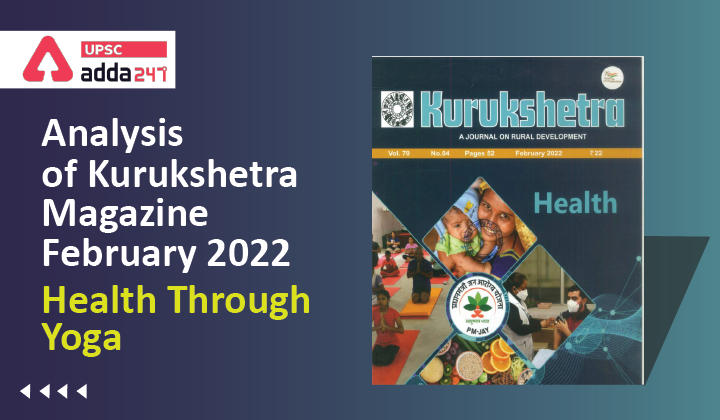Table of Contents
Analysis of Kurukshetra Magazine: ”Health Through Yoga”
Relevance
”GS 1: Ancient Indian Practices”
”GS 3: Health”
Introduction
- Yoga is an all-inclusive and specifically fine-tuned process of uniting the individual consciousness with the omnipresent enormous consciousness.
- As mentioned in the Upanishads, the principles of yoga deal with this awakening of the inner realms of the soul.
- Yoga is a complete discipline of strengthening and improving the physical, mental and spiritual state of being.
- It eliminates all physical and mental fatigue and help focusing the consciousness force into the deeper centres of the internal self.
Yoga, Health & Diseases
- If we perceive health as an integrated state of oneness (Advaita Sukham) and disease as the discordant lack of it (Dwaita Duhkham).
- Then Yoga becomes the tool as well as the methodology and process of re-integration/re-harmonization at all levels of our being.
- Even when Maharishi Patanjali mentions “vyadhi” as a hindrance (antharaya) to the complete integration of the individual personality towards liberation.
- He doesn’t directly refer to treatments of particular diseases, as his approach is more holistic and expanded rather than being analytical and limited.
- Patanjali prefers to ‘integrate’ rather than deal exclusively with individual symptoms of disintegration.
- Yoga Chikitsa (Yoga as a therapy) exists only when it is holistic, all-encompassing and integrated into every moment of one’s life with awareness and consciousness.
- The achievement of optimum health is only possible by the use of a holistic approach which caters to every one of its dimensions. Yoga emerges as the perfect candidate for this purpose.
Ashtanga Yoga and Holistic Approach to Health
• Asanas (postures) and shat kriyas (cleansing procedures) improve the physical component of health.
• Dhyana (meditation) and Dharana (concentration) improve mental health.
• Yama (discipline) and Niyama (observance) are universal rules of morality and social conduct laid down by sage Patanjali. They are similar to modern principles of public health and community medicine.
• The practices of pranayama (breath regulation) and pratyahara (withdrawal of the senses) improve emotional health.
• Yoga also strongly advocates the importance of surrender to the Almighty or Ishvarapranidhana. This encourages the development of spiritual health in an individual.
The science of Yoga
- The science of Yoga pertaining to the physical aspects of life focus on improving health and augmenting the strength of the body.
- The initial stage of yoga sadhana deals with the practices of asanas, pranayama and several yogic- kriyas of refinement.
- The physical exercise specific postures of the body practised through different Asanas, bandhas and mudras harmonies the intra-body and brain functions and facilitate activation of otherwise dormant vital energy centers, as one makes progress in yoga.
- The exercises ( kriyas) like Neti, dhouti, basti, nauli, vajroli, kapalbhati, etc taught under “Hathayoga” for internal purification of the body – system also fall under this category.
- The discipline of fasting, austerity, penance, etc help in cleansing the body and the mental domains and help in enhancing self-control.
Advantage of Yogasanas on other exercises
- Asanas are scientifically adviced modes of physical exercises that work on the mind-body system in a natural way.
- For example, the stretching and compression of the muscles, these practices regulate the blood flow in a balanced manner, inducing energetic freshness in the body components; it also increases the flexibility of the muscles.
- The other fitness exercises e. g. Danda- baithaka and some of the aerobics might give rapid results but these usually harden the muscles and there is a risk of wear and tear into them due to excessive pressure.
- Another advantage of yoga asanas is that if any asana corresponds to forward bending, there is also another in the same set of asanas, which requires backward bending and thus it makes a perfect sequence in terms of biomechanics as well.
- Yoga is a simple way of life which is loaded with all components or determinants (Ashtanga yoga) of health in the form of different practices which yield better outcomes in all planes of being when practised together in its original sense.
Conclusion
In conclusion, it is evident that the holistic approach of yoga therapy targets total integrated treatment or management of an individual at all levels of being. It is, therefore, the best way to achieve optimal health at a multi-dimensional level. In order to achieve the perfect harmonious state of the mind and body, yoga must not only be used as a therapy, rather it must be adopted as a way of life.



 TSPSC Group 1 Question Paper 2024, Downl...
TSPSC Group 1 Question Paper 2024, Downl...
 TSPSC Group 1 Answer key 2024 Out, Downl...
TSPSC Group 1 Answer key 2024 Out, Downl...
 UPSC Prelims 2024 Question Paper, Downlo...
UPSC Prelims 2024 Question Paper, Downlo...
